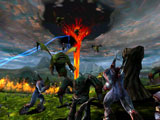 Here’s an E3 memory. I’m walking down the long hallway
between the big halls, when all of the sudden an attractive young woman (as if there is
any other kind at E3) spies my press badge and asks me if I’ve seen the Interplay
booth. Nope, I tell her, but I’ve got an appointment in an hour. She then asks if
I’d like to see something really special now, and (no fool me) I say sure. So
she leads me to the well-guarded Interplay booth, where I am ushered over to a guy
who’s playing a game—well, a game like I’ve never seen before. First of all
it’s beautiful—it has amazing lighting effects and stunning creature models and
a vast game world. And it’s sort of crazy, too—there’s tons of kinetic
combat and spells shooting off everywhere and something is going on about creatures
sacrificing other creatures on altars to their gods. What is this? I ask my guide.
It’s Sacrifice, I’m told, a new game by Shiny, makers of Earthworm Jim, MDK, and
other good things. My God, I say, my jaw agape. Why didn’t anybody tell me about
this? I wasn’t alone in my surprise, either. Shiny held back on telling anyone about
Sacrifice until it was just about done, mostly because of the the heat they took for the
long-delayed and ultimately disappointing Messiah. Here’s an E3 memory. I’m walking down the long hallway
between the big halls, when all of the sudden an attractive young woman (as if there is
any other kind at E3) spies my press badge and asks me if I’ve seen the Interplay
booth. Nope, I tell her, but I’ve got an appointment in an hour. She then asks if
I’d like to see something really special now, and (no fool me) I say sure. So
she leads me to the well-guarded Interplay booth, where I am ushered over to a guy
who’s playing a game—well, a game like I’ve never seen before. First of all
it’s beautiful—it has amazing lighting effects and stunning creature models and
a vast game world. And it’s sort of crazy, too—there’s tons of kinetic
combat and spells shooting off everywhere and something is going on about creatures
sacrificing other creatures on altars to their gods. What is this? I ask my guide.
It’s Sacrifice, I’m told, a new game by Shiny, makers of Earthworm Jim, MDK, and
other good things. My God, I say, my jaw agape. Why didn’t anybody tell me about
this? I wasn’t alone in my surprise, either. Shiny held back on telling anyone about
Sacrifice until it was just about done, mostly because of the the heat they took for the
long-delayed and ultimately disappointing Messiah.  We’ve been playing our beta and final
gold of Sacrifice for about a month now, and we will unequivocally make this
pronouncement: Sacrifice is the most graphically stunning computer game we’ve ever
played. This is not something we’re saying lightly, either; I’ve had people over
to the house, watched their jaws drop, and asked them if they’ve ever seen a
better-looking game. Nope, they say. I lie awake in bed at night, trying to come up with a
more gorgeous title—Unreal? Nope. Quake III? No. Even better, the graphics are
invested with the sort of inspired and creepy whimsy that's typical of Shiny. Landscapes
and creatures are Boschean amalgams that seem vaguely familiar yet strikingly original,
spell effects are spectacular, and the overall effect is staggering. Of course, all this
requires a pretty hefty machine, and when the action gets crazy (more on that later) you
can get some slowdowns, even on a boss rig. Fortunately for those with computers less
powerful than the NSA's, you're given a vast array of graphic options so you can tweak
away until you get things running smoothly. And that still may be difficult without at
least a 450 and a decent video card. We’ve been playing our beta and final
gold of Sacrifice for about a month now, and we will unequivocally make this
pronouncement: Sacrifice is the most graphically stunning computer game we’ve ever
played. This is not something we’re saying lightly, either; I’ve had people over
to the house, watched their jaws drop, and asked them if they’ve ever seen a
better-looking game. Nope, they say. I lie awake in bed at night, trying to come up with a
more gorgeous title—Unreal? Nope. Quake III? No. Even better, the graphics are
invested with the sort of inspired and creepy whimsy that's typical of Shiny. Landscapes
and creatures are Boschean amalgams that seem vaguely familiar yet strikingly original,
spell effects are spectacular, and the overall effect is staggering. Of course, all this
requires a pretty hefty machine, and when the action gets crazy (more on that later) you
can get some slowdowns, even on a boss rig. Fortunately for those with computers less
powerful than the NSA's, you're given a vast array of graphic options so you can tweak
away until you get things running smoothly. And that still may be difficult without at
least a 450 and a decent video card.
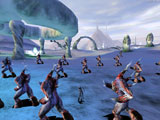 Of course, graphics aren't everything, and without decent
gameplay Sacrifice would just be a pretty curiousity. Sacrifice has both a campaign and
multi-player game. In the campaign game, you take the role of Eldred, a wizard who has
fled the destruction of his own world and now finds himself in a world dominated by five
powerful and squabbling gods. These include Persephone, a touchy and self-righteous nature
goddess; James, a peaceful, slow-on-the-uptake earth god (who looks a lot like Earthworm
Jim); Stratos, balloon-headed and arrogant Empyrean; Pyro, a stogie-chomping captain of
industry; and Charnel, who’s just evil. Throughout the campaign, which consists of
ten missions, you can choose to serve any of these gods. Each god has its own stable of
creatures and rack of spells, and as you progress in the campaign you'll accrue better and
more powerful spells and minions. The really cool thing is that you can mix and match 'em.
For instance, if you choose to serve James in the first mission, you'll be given three
basic Earth creatures and a couple of Earth spells. If you wish, you can continue to serve
James and gain all the Geomancy creatures and spells. On the other hand, you could choose
to serve Charnel in the next mission, and thus add some undead creatures and a couple of
Necromancy spells. With five gods, this means that the 10-mission campaign will play
differently every time. Of course, depending upon whom you serve and whom you fight
against, some of the gods might eventually take a dislike to you, but those are the risks. Of course, graphics aren't everything, and without decent
gameplay Sacrifice would just be a pretty curiousity. Sacrifice has both a campaign and
multi-player game. In the campaign game, you take the role of Eldred, a wizard who has
fled the destruction of his own world and now finds himself in a world dominated by five
powerful and squabbling gods. These include Persephone, a touchy and self-righteous nature
goddess; James, a peaceful, slow-on-the-uptake earth god (who looks a lot like Earthworm
Jim); Stratos, balloon-headed and arrogant Empyrean; Pyro, a stogie-chomping captain of
industry; and Charnel, who’s just evil. Throughout the campaign, which consists of
ten missions, you can choose to serve any of these gods. Each god has its own stable of
creatures and rack of spells, and as you progress in the campaign you'll accrue better and
more powerful spells and minions. The really cool thing is that you can mix and match 'em.
For instance, if you choose to serve James in the first mission, you'll be given three
basic Earth creatures and a couple of Earth spells. If you wish, you can continue to serve
James and gain all the Geomancy creatures and spells. On the other hand, you could choose
to serve Charnel in the next mission, and thus add some undead creatures and a couple of
Necromancy spells. With five gods, this means that the 10-mission campaign will play
differently every time. Of course, depending upon whom you serve and whom you fight
against, some of the gods might eventually take a dislike to you, but those are the risks.
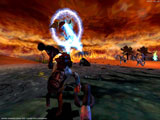 As far as gameplay goes, Sacrifice is a difficult game to
pigeonhole. In many ways, the game it plays most like is Myth—in both, you take
command of a small army of troops and fight tactical real-time battles. But unlike Myth,
in Sacrifice your character actually takes part in these battles. During gameplay, you'll
control your wizard from a third-person perspective using the standard WASD Quake
controls; you cast spells, command troops, and summon creatures using the mouse and/or
hotkeys. Though your character possesses powerful magic skills, his melee skills are
negligible, and in combat your role is really to stand back and command your troops while
throwing the occasional powerful spell at the bad guys and collecting stray souls (more on
this later). While this makes for exciting gameplay, this ground-level view can make
commanding your troops difficult. Again unlike Myth, Sacrifice is fast. Even
though the interface is easy-to-use and pretty intuitive, sometimes the game gets so
hectic that even the most accomplished RTSer will feel buffaloed. As far as gameplay goes, Sacrifice is a difficult game to
pigeonhole. In many ways, the game it plays most like is Myth—in both, you take
command of a small army of troops and fight tactical real-time battles. But unlike Myth,
in Sacrifice your character actually takes part in these battles. During gameplay, you'll
control your wizard from a third-person perspective using the standard WASD Quake
controls; you cast spells, command troops, and summon creatures using the mouse and/or
hotkeys. Though your character possesses powerful magic skills, his melee skills are
negligible, and in combat your role is really to stand back and command your troops while
throwing the occasional powerful spell at the bad guys and collecting stray souls (more on
this later). While this makes for exciting gameplay, this ground-level view can make
commanding your troops difficult. Again unlike Myth, Sacrifice is fast. Even
though the interface is easy-to-use and pretty intuitive, sometimes the game gets so
hectic that even the most accomplished RTSer will feel buffaloed.
 Like most RTS's, Sacrifice has a resource management model, but
it's so loopy and innovative and well-intergrated into the game that it's not the pain
that resource gathering typically becomes. In Sacrifice, you need two main resources--mana
to cast magic spells and souls to create creatures. Mana is obtained by finding one of the
mana founts scattered across the maps and building a manalith on it. But watch out--if you
get too far away from it, your mana won't regenerate and enemy wizards will soon slip in
and take it over. Fortunately, you can defend your manaliths by connecting creatures to
them with a handy guardian spell, and you can cast spells while away from home by
using a creature called a manahoar--sort of a portable mana generator. On the other hand,
souls are gathered by killing enemy minions--and sometimes innocent bystanders. Once you
kill an enemy creature, you can summon a Sac Doctor, who will then drag that enemy's soul
to your altar and sacrifice it. This "converts" the enemy's soul, which you can
then use to create a creature of your own. It's all pretty weird, but it works. Like most RTS's, Sacrifice has a resource management model, but
it's so loopy and innovative and well-intergrated into the game that it's not the pain
that resource gathering typically becomes. In Sacrifice, you need two main resources--mana
to cast magic spells and souls to create creatures. Mana is obtained by finding one of the
mana founts scattered across the maps and building a manalith on it. But watch out--if you
get too far away from it, your mana won't regenerate and enemy wizards will soon slip in
and take it over. Fortunately, you can defend your manaliths by connecting creatures to
them with a handy guardian spell, and you can cast spells while away from home by
using a creature called a manahoar--sort of a portable mana generator. On the other hand,
souls are gathered by killing enemy minions--and sometimes innocent bystanders. Once you
kill an enemy creature, you can summon a Sac Doctor, who will then drag that enemy's soul
to your altar and sacrifice it. This "converts" the enemy's soul, which you can
then use to create a creature of your own. It's all pretty weird, but it works.
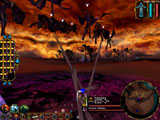 While the campaign game is a lot of fun, it's ultimately a
little disappointing because most missions tend to get settled in pretty predictable ways.
In most games, I used the following strategy--grab mana founts near my altar, build
manaliths, attach guardians to them. Wait for stupid enemy to rush my altar, kill a bunch
of them, convert their souls, build more creatures and slowly "manalith-hop"
until I desecrate enemy's altar, ending game. Frankly, enemy AI is pretty bad in the game,
and it seems most enemy wizards tend to use "minion rush" tactics. This is a
shame, because the creatures in Sacrifice have wildly different abilities and the spells
are very original, and there are plenty of opportunities for tactical ingenuity. Some
creatures are good at melee, some at ranged combat, some can fly. Almost all have powerful
special abilities. High ground matters. You can easily group your creatures and arrange
them in several formations, including line, circle, guard, and phalanx. And the spells are
varied and useful--from Rain of Frogs to the Rain of Fire, they can easily swing the
course of missions.. Unfortunately, in the campaign game I didn't really take advantage of
all the game had to offer, which I will conveniently blame on the poor enemy AI. I
imagine that if I had to think a little, I probably might have used these abilities in
ingenious ways. While the campaign game is a lot of fun, it's ultimately a
little disappointing because most missions tend to get settled in pretty predictable ways.
In most games, I used the following strategy--grab mana founts near my altar, build
manaliths, attach guardians to them. Wait for stupid enemy to rush my altar, kill a bunch
of them, convert their souls, build more creatures and slowly "manalith-hop"
until I desecrate enemy's altar, ending game. Frankly, enemy AI is pretty bad in the game,
and it seems most enemy wizards tend to use "minion rush" tactics. This is a
shame, because the creatures in Sacrifice have wildly different abilities and the spells
are very original, and there are plenty of opportunities for tactical ingenuity. Some
creatures are good at melee, some at ranged combat, some can fly. Almost all have powerful
special abilities. High ground matters. You can easily group your creatures and arrange
them in several formations, including line, circle, guard, and phalanx. And the spells are
varied and useful--from Rain of Frogs to the Rain of Fire, they can easily swing the
course of missions.. Unfortunately, in the campaign game I didn't really take advantage of
all the game had to offer, which I will conveniently blame on the poor enemy AI. I
imagine that if I had to think a little, I probably might have used these abilities in
ingenious ways.
Which is why the multiplayer
game is so good. Sacrifice includes 35 multiplayer maps, four different multiplayer modes,
and a powerful and remarkably easy-to-use editing tool. This portends a lot of online
variety, but the best thing about playing online is that human players are a lot smarter
than computer ones, and the game's full tactical possibilities
only come out during mano a
mano matches. Again, after playing the campaign game, I was a little disappointed in the
game's depth. After having my head handed to me a couple of times in multiplayer, I'm
impressed. And determined to get ingenious in a hurry.
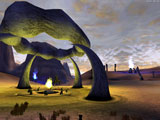 Sacrifice is a true original, and as with any original, it's
difficult to pass judgment on it. Though the game's combination of superb graphics,
whimsy, humor, unconventional gameplay and amazing variety makes it a no-brainer
recommendation for action and strategy fans, while playing online I got the feeling that
nobody really knows what they're doing with this game yet. And in a a genre that's
become all too predictable, that's perhaps the highest recommendation of all. Sacrifice is a true original, and as with any original, it's
difficult to pass judgment on it. Though the game's combination of superb graphics,
whimsy, humor, unconventional gameplay and amazing variety makes it a no-brainer
recommendation for action and strategy fans, while playing online I got the feeling that
nobody really knows what they're doing with this game yet. And in a a genre that's
become all too predictable, that's perhaps the highest recommendation of all.
Rick
Fehrenbacher |
